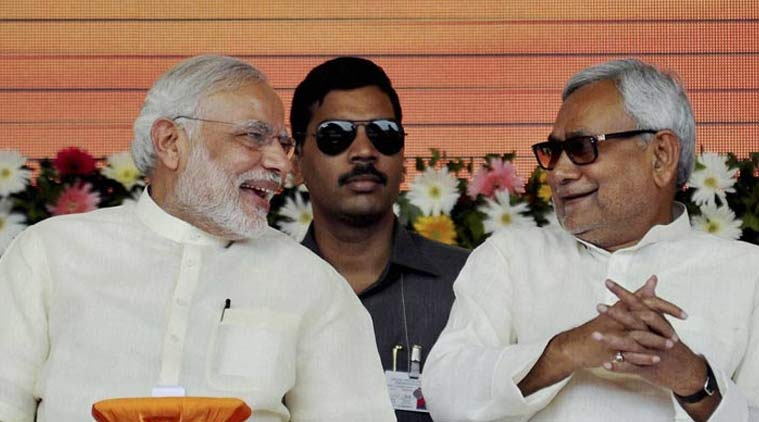Decoding the data: Nitish ahead among Mahadalits but BJP closes the gap
The Mahadalits, 20 of the poorest Dalit sub-castes, who were once behind the RJD, have shifted their allegiance towards the BJP and the JD(U) over the last 15 years.
 The Mahadalits, 20 of the poorest Dalit sub-castes, who were once behind the RJD, have shifted their allegiance towards the BJP and the JD(U) over the last 15 years.
The Mahadalits, 20 of the poorest Dalit sub-castes, who were once behind the RJD, have shifted their allegiance towards the BJP and the JD(U) over the last 15 years.
By Shreyas Sardesai
Dalit politics in Bihar, which for a long time has been mainly associated with Ram Vilas Paswan’s LJP, has over the last eight years been reinvented, first by Nitish Kumar who created the Mahadalit category to woo the non-Paswan Dalit castes and then by Jitan Ram Manjhi who rebelled against Nitish months after his appointment as chief minister. Manjhi actively cultivated his image as a Dalit leader by announcing several welfare schemes for the community. With both Manjhi and Paswan now on the BJP’s side, it is being widely predicted that a majority of Dalits, who constitute one-sixth of the population, will tilt towards the saffron alliance. However, an analysis of their past voting patterns derived from CSDS surveys reveals that the going may not be so easy, at least among the non-Paswan Dalits.
Mahadalits (5%)
The Mahadalits, 20 of the poorest Dalit sub-castes, who were once behind the RJD, have shifted their allegiance towards the BJP and the JD(U) over the last 15 years. There has in fact been a steady decline in support among Mahadalits for the RJD with every passing election since 2000. A party that once used to win nearly half the Mahadalit votes now barely wins one in ten votes. The RJD’s loss has been the JD(U)’s and the BJP’s gain. The two parties in alliance netted 33 to 36 per cent of the Mahadalit vote between 2004 and 2009, which increased to 40 per cent in 2010. Among the two, the JD(U) did better than the BJP in 2004 and February 2005 whereas the BJP did better in October 2005 and 2009. It was in the 2010 election, however, that the JD(U) outdid its ally by a large margin, 30 per cent to the BJP’s 11 per cent. Since then, the support of Mahadalits for the JD(U) has remained firm with 34 per cent voting for it in 2014. The BJP, however, has been the biggest gainer with the party’s Mahadalit support rising between 2010 and 2014 from just one in ten votes to one in four. Assuming that many Mahadalits voted for the BJP in 2014 due to the “Modi factor”, the challenge for the party will be to retain their support, now that Modi will be less of a factor in a state election. The challenge for the JD(U) on the other hand is to convince the Mahadalits to stay with it now that Manjhi is no longer with it.
Chamars (6%)
The Chamars (also a Mahadalit caste but treated as a separate category here for analysis) too have over the last 15 years moved away from the RJD, the Congress and other smaller entities towards the BJP, the JD(U) and the BSP. The BJP, which in 2000 won 7 per cent of Chamar votes, has made significant inroads into the community. The party received 15 per cent of Chamar votes in 2010 and increase it to 20 per cent in 2014. If we take into account votes polled for the LJP, then the share for the BJP alliance was one-third. Meanwhile, the combined share of the JD(U), the RJD and the Congress among Chamars was 30 per cent.
Interestingly, the largest proportion of Chamar votes in Bihar has been going to the BSP for a long time. Mayawati’s party has consistently won between one-fourth and one-third of Chamar votes since 2005. Significantly, even amidst the so-called Modi wave in 2014, more Chamars voted for the BSP than for the BJP. Mayawati may not be much of a factor in Bihar politics, but her party’s strong following can be a significant impediment to the NDA’s attempts to consolidate the Dalit vote.
Pasis and Paswans (5%)
The Pasis and Paswans, politically, socially and economically the strongest of all Dalit sub-castes of Bihar, have stayed loyal to Ram Vilas Paswan and their voting pattern over the years has been determined by which party Paswan’s LJP has been in alliance with. In election after election, Paswan has been successful in transferring the Pasi vote to the party he has aligned with. In 2004, when LJP went with RJD and Congress, 58 per cent of Pasis voted for RJD. In February 2005 when Paswan was with Congress, 60 per cent of Pasis voted for the combine. In 2009 and 2010 when LJP contested with Lalu, half the Pasis voted for the alliance. Finally, in 2014 when LJP tied up with BJP, 41 per cent of Pasis voted for BJP. Clearly, the Pasi vote is the most predictable and barring a surprise it is almost certain to go the saffron way this time.
Gender division
Finally, the 2014 Lok Sabha election saw a significant gender division in voting opening up among Dalits. CSDS data reveal that Dalit men voted for the BJP-LJP-RLSP alliance in much greater proportion than Dalit women — 46 per cent to 39. Moreover, while the gap in terms of votes between the BJP alliance and the JDU-RJD-Congress (if we add up their votes) among Dalit men was a whopping 20 percentage points, among Dalit women it was a neck-and-neck battle as both formations got around 40 per cent votes each. This differing voting pattern was seen only among Dalits, while among the OBCs and upper castes, men and women voted more or less similarly.
Shreyas Sardesai is research associate at Lokniti, Centre for the Study of Developing Societies, Delhi
This article is part of a series from Lokniti-CSDS that analyses various dimensions of Bihar politics using evidence from surveys conducted by Lokniti over the last two decades
Photos


- 01
- 02
- 03
- 04
- 05
































